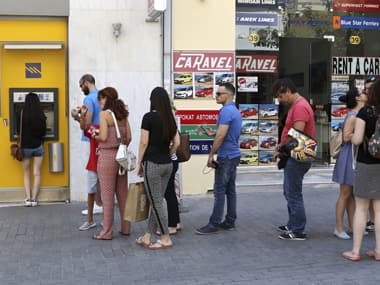Most economists expect that there isn’t any immediate concern for India on account of current developments in Greece, where that country is on the verge of defaulting to global creditors, but warn contagion of the crisis to rest of the European region could eventually force a defensive play on policymakers in emerging economies. To be sure, compared with previous crisis periods, India is much better positioned to face any global unrest. The country has foreign exchange reserves of $355 billion (compared with $252 billion in 2008-09 period), relatively stable currency and improved fundamentals. Economists such as Crisil’s D K Joshi say what is critical is uneven global recovery and Greece in particular should act as a reminder to the NDA government that India’s economic recovery should largely depend on domestic, not external, drivers. [caption id=“attachment_2317422” align=“alignleft” width=“380”]  Reuters[/caption] “Greece isn’t a major worry at this stage, but a source of volatility. If the global demand further takes a major hit on account of this, Indian exports can further slowdown. The better way of handling this situation is not to delay the public investment spending push and build a strong, domestic-driven story,” Joshi said. (Meanwhile, finance secretary Rajiv Mehrishi has said the financial crisis in Greece may have an indirect impact on India and the government is in touch with the RBI to deal with the situation, Reuters reported.) India has already taken a hit on the export front. In May, the country’s exports contracted for the sixth month in a row, when they plunged 20.19 percent to $22.34 billion. The fall has been mainly due to global slowdown and a fall in crude oil prices. Possible contagion of Greece crisis to other markets, can worsen the scenario. The Federation of Indian Exports Organisations, an industry body of exporters, has already warned of further export slowdown looking at the current order book position. Such a scenario could also lead to reallocation of resources to emerging markets from European region, which would mean countries like India would witness large-scale capital inflows impacting the exchange rate, said Madan Sabnabvis, chief economist at Care. The Rupee has already been highly volatile this year. Since the beginning of this year, the rupee has lost 1.32 percent but has gained 7.12 percent from its all-time low of 68.80 on 28 August 2013. So far this year, foreign institutional investors have bought $12.82 billion from local equity markets. On Monday, the rupee opened at 63.74 against the dollar, down 10 paise from Friday’s close, and is currently trading at 63.90. The currency has largely traded steady this year but the RBI governor has cautioned that it still faces the danger of falling sharply due to external factors. Also, possible spreading of the crisis in Greece to German or other European banks could upset the RBI’s assessments on inflation. In the 2 June monetary policy, the RBI has said that it is keeping a close watch on the global markets. “Volatility in global bond markets has increased with a number of factors at play: unwinding of European assets by investors due to the Greek crisis; rapidly changing expectations around the Fed’s forward guidance; sharp movements in crude prices; and market corrections due to changes in risk tolerance,” the RBI had said. In fact, the RBI has been guiding the government that India needs to pin its hopes on domestic demand for growth recovery, rather than an export-driven growth. In the June policy too, the RBI has spoke about this in the context of falling exports. “Net exports are, therefore, unlikely to contribute as much to growth going forward as they did in the past financial year. Consequently growth will depend more on a strengthening of domestic final demand,” RBI said. In the past, RBI governor, Raghuram Rajan has attracted criticism on questioning the premises of NDA government’s Make in India campaign, which is based on export-led model. Rajan said the drive should focus on tapping the domestic demand strength instead of hoping for a China-like export-led model in a slowing and uncertain world. The country needs to look to “regional and domestic demand for our growth - to make in India primarily for India”, Rajan said, adding if external demand growth is likely to be muted, we have to produce for the internal market. “This means we have to work on creating the strongest sustainable unified market we can, which requires a reduction in the transactions costs of buying and selling throughout the country.” In short, though Greece isn’t a danger to India, the crisis there can significantly generate pessimism among global investors and India should guard itself by strengthening the domestic fundamentals. According to Crisil’s Joshi, supporting investor sentiments in a pessimistic global scenario is key for India to continue with its revival story. “The short message is that the government needs to push the key reforms — land bill and GST — and keep spending to revive the economic activities. There aren’t any significant investment pick-up seen yet (in the domestic market)’. To be sure, there are some positive signals emerging from recent macro-data. Economists note that the 11.1 percent growth in capital goods — an indicator of corporate investment activity — in April compared with 8.7 percent in the previous month is encouraging. If the government begins its promised public investment push in key sectors, the early signs of revival seen in the industrial activities can take firm hold, despite what happens globally.
If the government begins its promised public investment push in key sectors, the early signs of revival seen in the industrial activities can take firm hold, despite what happens globally
Advertisement
End of Article


)

)
)
)
)
)
)
)
)



